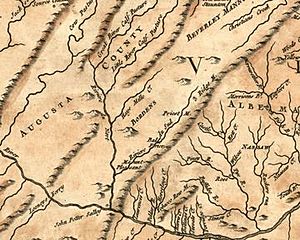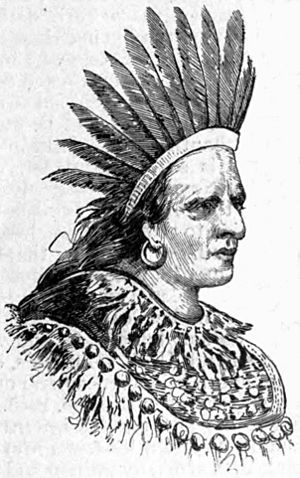Battle of Galudoghson facts for kids
Quick facts for kids Battle of Galudoghson |
|||||||
|---|---|---|---|---|---|---|---|
|
|||||||
| Belligerents | |||||||
| Onondaga, Oneida Indians (Iroquois) | |||||||
| Commanders and leaders | |||||||
| Colonel James Patton, Captain John McDowell, Captain John Buchanan | Jonnhaty | ||||||
| Units involved | |||||||
| Augusta County militia (Virginia militia) | Iroquois war party | ||||||
| Strength | |||||||
| 33 militia troops, some mounted | 29-36 Iroquois warriors | ||||||
| Casualties and losses | |||||||
| 8 dead | 3-17 dead, 5 wounded | ||||||
In December 1742, a fight happened near what is now Glasgow, Virginia. This battle was between the Augusta County militia and a group of Onondaga and Oneida Indians. These Native American warriors had traveled from Shamokin in Pennsylvania. They were led by an Iroquois chief named Jonnhaty. Their main goal was to fight against the Catawba people.
This event was the first armed conflict between European settlers in Western Virginia and Native Americans. There are three different stories about what happened, and some details don't match up. The Iroquois people felt this battle was an attack without reason. However, the Virginia colonists said the Iroquois had bothered their settlements and harmed their animals.
Contents
What's in a Name? The Battle of Galudoghson
This battle didn't have a formal name for a long time. In 1995, a historian named Lyman Draper had his papers published after he passed away. In his writings, he named the fight "the Battle of Galudoghson." This name comes from the Iroquois name for the James River.
Why the Battle Happened: Background Story
In the 1730s, the Six Nations leaders met several times in Pennsylvania. They often said they hadn't been paid fairly for their traditional lands. These lands were being taken over by European settlers. This made officials in Pennsylvania, Maryland, and Virginia worried about possible violence.
In 1742, rumors spread in Maryland. People heard that Native American groups might attack the English settlers. They also heard that the French might help these attacks. During a meeting in Philadelphia in July, a chief named Canasatego warned that if they didn't get fair payment, "we are able to do ourselves Justice." This worried the Pennsylvania government. To try and keep the peace, they gave gifts to the Iroquois leaders. These gifts included gunpowder, lead, and guns.
In December 1742, a group of 22 Onondaga and 7 Oneida Indians warriors entered Virginia. They started bothering settlers and killing their farm animals. Many colonists thought this meant a big attack was coming. However, the local militia leader, Colonel James Patton, wanted to avoid a fight. He sent a militia group, led by Captain John McDowell, to guide the warriors out of Augusta County.
Virginia Settlers' Stories of the Battle
In 1808, Captain John McDowell's son, Samuel McDowell, wrote a letter about the battle. He said that Jonnhaty's group of 33 warriors came into Virginia. They traveled south along the Great Indian Warpath to an area called "Borden's Tract." On December 1, they stopped at John McDowell's home. They were given food and drinks.
Then, the warriors traveled to the James River, which they called the Galudoghson. They set up camp near where the Maury River joins it. Local settlers told McDowell that the Native Americans had killed some of their pigs and horses. They also said the warriors "went to Peoples houses, Scared the women and Children [and] took what they wanted."
On December 15, McDowell contacted his commander, Colonel Patton. Patton ordered McDowell and his 33-man militia to escort the warriors out of Augusta County. The militia found the warriors on December 17 near John Peter Salling's home. They followed them from a distance for two days.
One of the Native American warriors fell behind the group. He went into the forest near Balcony Falls. A militiaman then shot at him. The warrior cried out, and the other Native Americans started shooting. They killed two mounted soldiers and Captain John McDowell. At that moment, McDowell was riding at the front of the group with Jonnhaty, talking to him.
In the fight that followed, three or four Native American warriors were killed. Samuel McDowell later said 17 were killed. Eight or ten militiamen also died. Colonel Patton said the Native Americans ran into the forest. Captain Buchanan and eight militiamen chased them for a short distance.
Other settlers who saw the battle said the Native Americans had killed several farm animals. They also said Captain McDowell approached the group with a white flag to talk. But the Native Americans fired and killed him and some of his men before the militia shot back. Samuel McDowell said the militia shot first. But he blamed the Iroquois for not respecting the settlers' property by killing their animals.
Colonel Patton wrote a letter to Virginia Governor William Gooch on December 18. He said a man with a white flag was killed by the Native Americans. He reported that eight or ten warriors were killed, and eleven militiamen, including Captain McDowell, died. Patton said he arrived with 23 more soldiers a few hours after the fighting ended.
On December 23, Patton sent a new report to Governor Gooch. He said there were 36 warriors. He also said that on December 19, two men were sent with a white flag, asking for "Peace and Friendship." Patton noted that before shooting, the Native Americans had called out, "O friends are you there, have we found you?" He said eight militiamen were killed but didn't say how many were hurt.
Native American Story of the Battle
Shikellamy's grandson, who was part of the battle, told his story in February 1743. He said that soon after they crossed the Potomac River, white settlers surrounded them. The settlers thought the warriors planned to raid Virginia homes and tried to take their guns. When one warrior pulled out a knife, the settlers let them go.
Two days later, ten settlers with pitchforks stopped the warriors. They took them to a "big House" full of white people. The warriors were invited inside, but only a few of the older ones dared to go in. A white man with a sword, who the warriors called a captain, tried to get the others to come inside, but they refused.
The warriors showed a written pass from Pennsylvania officials. This pass gave them permission to travel. But the settlers told them they couldn't continue. The warriors then left the house. The "captain" then waved his sword, telling them not to leave. The warriors got ready to fight. But Jonnhaty told them "to be quiet till they were hurt."
The war party traveled for three days. While they were camped, a white man, likely a scout, arrived and counted them. He told the Native Americans he was a hunter and then left.
The Native Americans were on the road when "a Great number of white Men on horseback" came toward them with a white flag. Two young boys with the war party got scared and ran away. Some of the white men shot at them but missed. Jonnhaty told his men not to shoot back. He said that "a white Colour [flag] was always a token of Peace among the white Men." The horsemen then got off their horses and shot again. They killed two warriors, one of whom was Shikellamy's cousin. The warriors then shot back and attacked with hatchets.
The white men ran away. Jonnhaty told his men not to chase them. He said they came to Virginia to fight Catawbas, not white men. They found eight white men killed and took several horses. Five warriors were hurt, but the number of dead was not reported. Ten warriors went back with the wounded to Great Island (now Lock Haven, Pennsylvania). They arrived on January 12 or 13. They told their story, which was heard by community leaders and a trader named Thomas McKee. McKee reported what he heard on January 26.
What Happened After the Battle
Samuel McDowell said that local settlers found the dead militiamen. They put the "bloody corpses on horseback and laid them side by side near McDowell's dwelling." They then prepared their graves with great sadness. Captain McDowell was buried in the McDowell family burial plot in Fairfield, Rockbridge County, Virginia.
Patton wrote to Governor Gooch that he heard reports from the militia. They said they saw "white men supposed to be French among the Indians." Patton responded by ordering "patrols on all our frontiers." These patrols were well-equipped. He also had young men from each company ready to help any group or place that needed it. Patton added that they had news of 150 Native Americans seen 70 miles away. He also heard that about the same number had recently crossed the Potomac River, heading their way.
Days after the battle, Governor Gooch called a meeting of the Virginia Council. They ordered that gunpowder and shot be sent to Patton. They also alerted the militia in Orange and Fairfax counties. In early 1743, Shikellamy traveled to Williamsburg to speak to the council. Gooch also wrote to New York governor George Clarke. He asked Clarke to find out "what Indian nation dared to treat His Majesties subjects in so insolent and outrageous manner." He also wanted to know "what part of this Government it is they dispute."
After hearing McKee's report of the Native Americans' story, Pennsylvania Lieutenant Governor George Thomas wrote to Gooch. Thomas said, "the Indians own that they kill'd some Hoggs to asswage their hunger." He thought this, along with their threats last year about land payments, caused the fight. Thomas didn't believe the Native Americans planned to attack Virginia settlers. He said, "Had they design'd hostilities, it is not probable they would have trust'd themselves in any of the white Inhabitants' houses, as some of them did upon their invitation."
In June 1743, Conrad Weiser was sent by Gooch to Onondaga. He was to meet with the Iroquois leaders. Gooch said they "have given me the strongest assurances that no fresh Hostilities shall be exercised against [the Virginia settlers]." While there, Weiser and the Iroquois leaders heard Jonnhaty's story. Weiser described Jonnhaty as "a very thoughtful and honest Man," who "took a deal of Time in telling the Story." The governor sent goods worth £100 with Weiser as a peace offering.
The battle was one reason colonial leaders decided to talk with Native American leaders. This led to the 1744 Treaty of Lancaster. This was one of several agreements where the Six Nations land cessions gave up land during the 1700s.
Remembering the Battle
A historical marker that remembers this event is located next to Virginia Route 130. It is where it meets U.S. Route 501 in Glasgow, Virginia.
Another historical marker is at John McDowell's gravesite. This is in the McDowell family burial plot in Fairfield, Rockbridge County, Virginia.



